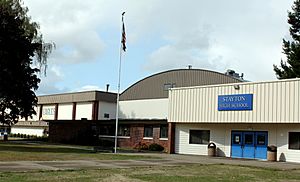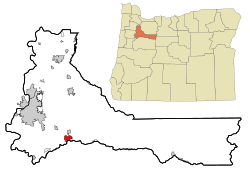Stayton, Oregon facts for kids
Quick facts for kids
Stayton, Oregon
|
||
|---|---|---|

Stayton High School
|
||
|
||

Location in Oregon
|
||
| Country | United States | |
| State | Oregon | |
| County | Marion | |
| Incorporated | 1891 | |
| Area | ||
| • Total | 3.11 sq mi (8.05 km2) | |
| • Land | 3.09 sq mi (8.01 km2) | |
| • Water | 0.01 sq mi (0.04 km2) | |
| Elevation | 456 ft (139 m) | |
| Population
(2020)
|
||
| • Total | 8,244 | |
| • Density | 2,666.24/sq mi (1,029.32/km2) | |
| Time zone | UTC-8 (Pacific) | |
| • Summer (DST) | UTC-7 (Pacific) | |
| ZIP code |
97383
|
|
| Area code(s) | 503 and 971 | |
| FIPS code | 41-70200 | |
| GNIS feature ID | 2411975 | |
| Website | www.staytonoregon.gov | |
Stayton is a city in Marion County, Oregon, United States. It is located about 12 miles (19 km) southeast of Salem, the state capital. Stayton is found on the North Santiam River and is known as a center for farming and light manufacturing. In 2020, the city had a population of 8,244 people. Stayton was first established in 1872 and became an official city in 1891. It is part of the larger Salem Metropolitan Statistical Area.
Contents
History of Stayton
Stayton was founded by a man named Drury Smith Stayton. He bought the land for the town in 1866. He then built a special mill to process wool and another mill to cut wood near the North Santiam River.
In 1872, Drury Stayton planned out the town's streets and lots. That same year, the community got its own post office. A ferry helped people cross the Santiam River from 1876 until a bridge was built in 1888. By 1880, a laundry business was started by Kee Sing and Tom. The first newspaper, The Stayton Sun, began in 1889.
Drury Stayton originally wanted to name the city after his daughter, Florence Stayton. However, the post office said no because another city in Oregon was already named Florence. So, he chose the name Stayton and named a street after his daughter instead. The city officially became the Town of Stayton in 1891.
Geography and Climate
Stayton covers a total area of about 2.86 square miles (7.41 square kilometers). Most of this area is land, with a small part being water.
Stayton's Weather
Stayton has a mild climate, similar to many places in the Pacific Northwest. Winters are usually mild and wet, while summers are warm and fairly dry.
In summer, especially July and August, temperatures can sometimes get very hot, even over 90°F (32°C). The warmest month is August, with an average daytime temperature of about 80.8°F (27.1°C).
Winters are generally mild and rainy. Sometimes, it can get very cold, and snow or ice storms can happen. The coldest temperature ever recorded in Stayton was −7°F (−22°C) on December 8, 1972.
Population Changes
Stayton has grown quite a bit over the years. Here's how its population has changed:
| Historical population | |||
|---|---|---|---|
| Census | Pop. | %± | |
| 1880 | 226 | — | |
| 1890 | 381 | 68.6% | |
| 1900 | 324 | −15.0% | |
| 1910 | 703 | 117.0% | |
| 1920 | 649 | −7.7% | |
| 1930 | 797 | 22.8% | |
| 1940 | 1,085 | 36.1% | |
| 1950 | 1,507 | 38.9% | |
| 1960 | 2,108 | 39.9% | |
| 1970 | 3,170 | 50.4% | |
| 1980 | 4,396 | 38.7% | |
| 1990 | 5,011 | 14.0% | |
| 2000 | 6,816 | 36.0% | |
| 2010 | 7,644 | 12.1% | |
| 2020 | 8,244 | 7.8% | |
| U.S. Decennial Census | |||
About the People in Stayton
In 2010, there were 7,644 people living in Stayton. There were 2,882 households, which are groups of people living together in one home. About 38% of these households had children under 18 living with them.
The average age of people in Stayton was 35 years old. About 28% of the residents were under 18, and about 13% were 65 or older.
Schools in Stayton
Stayton is part of the North Santiam School District. The public schools in the city include Stayton High School, Stayton Middle/Intermediate School, and Stayton Elementary School. There are also private Catholic schools: Regis High School and St. Mary Elementary School.
City Services
Santiam Hospital is the only hospital in Stayton. The Stayton Public Library is the city's only library. It is part of a larger library system called Chemeketa Cooperative Regional Library Service. Route 22 is the main state highway near Stayton.
Fun Places to Visit
- Pioneer Park is a local attraction. It has the Stayton–Jordan Bridge, which is a covered bridge. This bridge was moved to the park in 1988. It burned down in 1994 but was rebuilt and painted white. People often use it for special events like weddings.
- Kingston Prairie Preserve is about 3 miles (5 km) southeast of Stayton. This preserve protects a special area of native prairie. This type of grassland used to be common in the Willamette Valley.
- Silver Falls State Park is located northeast of Stayton. It is the largest state park in Oregon. It's a popular place for tourists, especially known for its camping and beautiful waterfalls.
Famous People from Stayton
- Jay Baller - a baseball pitcher
- Greg Brock - a Major League Baseball player
- Fred Girod - a politician
- Travis Lulay - a football player
- Albin W. Norblad - a judge
- A. Walter Norblad - a Congressman
- Terry Schrunk - a politician
- Wanda Brown Shaw - an educator
- Kassie Brown - an artist
Images for kids
-
Seep monkeyflower (Mimulus guttatus) is among the species protected in Kingston Prairie Preserve near Stayton.
See also
 In Spanish: Stayton para niños
In Spanish: Stayton para niños





